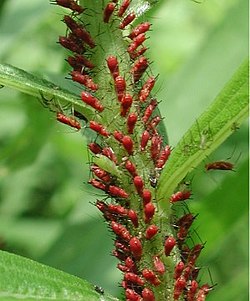Aphids are small bugs which feed on plants. Aphids cause more plant damage than any other insects.[1] There are over 4,000 different species of aphid.
| Aphids | |
|---|---|
 | |
| Scientific classification | |
| Kingdom: | |
| Phylum: | |
| Class: | |
| Order: | |
| Suborder: | Sternorrhyncha |
| Superfamily: | Aphidoidea |
About 250 species are serious pests for agriculture and forestry as well as an annoyance for gardeners. They vary in size from 1-10 mm long.
Important natural enemies include the predatory lady beetles (Coleoptera: Coccinellidae), hoverfly larvae, lacewings (Neuroptera), larvae of the aphid midge Aphidoletes aphidimyza, crab spiders, and insect-eating fungi like Lecanicillium lecanii.
Aphids are found many places on earth. Aphids are most common in temperate zones. Aphids can travel far in the air. For example, the lettuce aphid spread from New Zealand to Tasmania.[2] They have also been spread by human transportation of infested plant materials.

References
Wikiwand in your browser!
Seamless Wikipedia browsing. On steroids.
Every time you click a link to Wikipedia, Wiktionary or Wikiquote in your browser's search results, it will show the modern Wikiwand interface.
Wikiwand extension is a five stars, simple, with minimum permission required to keep your browsing private, safe and transparent.